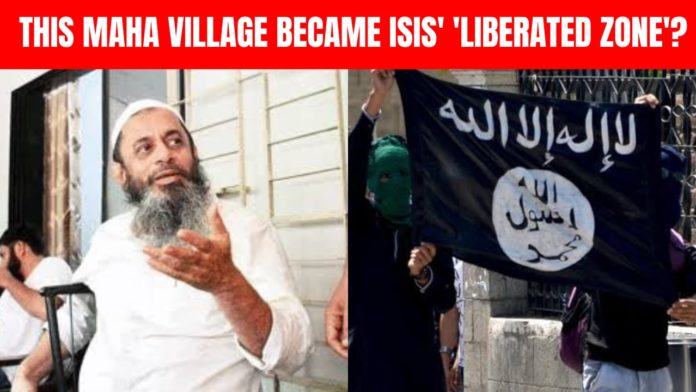Sagarika Mitra, Content Head of JAN KI BAAT, highlights shocking new details about NIA’s recent crackdown on this ISIS module, profiles its mastermind and asks critical questions about the need for a harsher approach towards terror convicts
Nestled 53 kilometers north of Mumbai, the serene village of Padgha in rural Thane has been thrust into the national spotlight due to a recent crackdown by the National Investigation Agency (NIA). Shockingly, alleged ISIS operatives have reportedly designated this quaint village as a ‘liberated zone’ and ‘Al Sham,’ sparking concerns about the extent of terror activities in the heartland of Maharashtra. The mastermind behind this ISIS module, 63-year-old Saquib Nachan, a convicted terrorist with a tumultuous past, stands accused of administering the ‘oath of allegiance to the Khalifa of ISIS’ to youth joining the outfit at the so-called ‘Padgha Base.’
Saquib Nachan’s terror stained history dates back to the late ’80s and early ’90s, marked by over 12 terror cases, two convictions, and 15 years behind bars. Despite convictions in 1997 for planning terror attacks and in 2006 for an Arms Act violation linked to the 2002-03 Mumbai blasts, Nachan was released in 2017. Along with Saquib Nachan, the 14 other arrested ISIS operatives have been identified as Hasiv Zuber Mulla, Kashif Abdul Sattar Balere, Saif Ateeque Machan, Rehan Ashfaque Suse, Shagaf Safiq Divakar, Firoz Dasragir Kuwari, Adil Iliyas Khot, Razil Abdul Latif Nachan, Farhan Ansar Suse, Mukhlis Maqbool Nachan and Munzir Abubakar Kunnathpeedikal. The arrests in Thane district have reignited concerns about ISIS operatives using rural areas as bases for fostering radicalisation and plotting terror activities.
How did ‘Padgha’ become an ISIS hotbed?
Padgha first grabbed national attention when five of its residents were implicated in the 2002-03 Mumbai triple blasts case. Former SIMI general secretary Saquib Nachan who is also the mastermind of the current ISIS module, was deemed the main conspirator He was arrested, tried, and later released. National Investigation Agency (NIA) officials contend that Padgha, which is nestled in the Thane district, was used by ISIS terror operatives as a breeding ground for radicalisation, primarily because of its strategic geographical location. Law enforcement officials assert that the dense cover of the Mahuli and Karwa hills, situated just beyond the village borders, has allegedly been exploited for training Muslim youth in subversive activities. This includes, as per police claims, the clandestine instruction in handling automatic weapons and the assembly of explosives. Pagdha is home to 5,700 residents, of which 83 per cent are Muslims as per the 2011 census.
Saquib Nachan: From SIMI Leader to ISIS Mastermind
At 63, Saquib Machan once again finds himself once again at the center of a major crackdown by the National Investigation Agency (NIA). He is accused of being the mastermind behind an ISIS module in India.
Born into a respected and affluent family with extensive land holdings in Borivali-Padhna, a Konkani Muslim-dominated village north of Mumbai, Nachan’s early years unfolded against a backdrop of relative prosperity. A Commerce graduate, he navigated from the Jamaat-e-Islaami to its student wing, the Students’ Islamic Movement of India (SIMI), in the early eighties. Nachan’s ascent within SIMI was swift. He served as the Maharashtra president and later as the general secretary of SIMI. Instrumental in organizing one of SIMI’s largest rallies in Mumbai, drawing over 10,000 attendees, Nachan’s leadership style would later be associated with pushing SIMI towards a violent path of terror.
Accused of having links to Khalistani terrorists, Pakistan’s Inter Services Intelligence (ISI), and SIMI, Nachan allegedly visited Pakistan twice in the 1990s. He was reportedly part of ISI’s ‘K2 Operation’, where ISI tried fomenting trouble by radicalising Khalistani activists and galvanising Islamist groups against India. Additionally, Nachan faced charges of murder and was accused of sending Muslims to Pakistan for arms training.
‘Zero Tolerance’ to terror: Questions that emerge on Saquib Nachan’s case
1. Why wasn’t Saquib Nachan, a convicted and highly radicalised terrorist, sentenced to the death penalty?
2. Given Nachan’s history of terror convictions, why was he released in 2017, and what measures were taken to monitor his activities post-release?
3. What judicial considerations led to relatively shorter sentences for Nachan, especially considering the gravity of his affiliations with Pakistan ISI and Khalistan?
4. Were there any assessments of the potential threat posed by Nachan upon his release, and what preventive measures were implemented to safeguard national security?
5. In light of Nachan’s alleged role in orchestrating terror attacks and murders, what factors influenced the decision to not impose a harsher punishment?
6. Were Nachan’s links with Pakistan ISI and Khalistan taken into account during the sentencing, and if so, how did they impact the judicial decision?
7. What steps have law enforcers taken to address the broader issue of radicalisation and the potential establishment of terror bases in villages like Padgha?
8. How can agencies ensure that individuals with known terror affiliations, like Nachan, are not able to resume activities that pose a threat to national security upon release?
As India grapples with the implications of ISIS modules extending their reach into rural areas, these questions underscore the urgent need for transparency and accountability to safeguard national security and protect citizens from potential terror threats.

